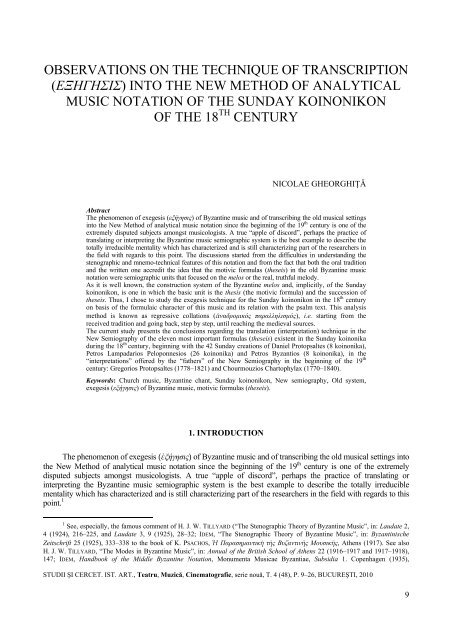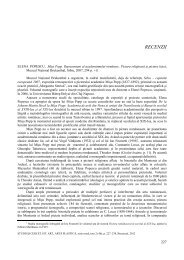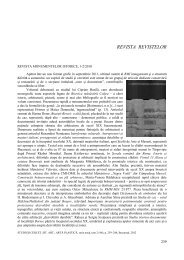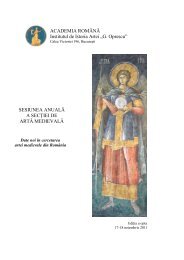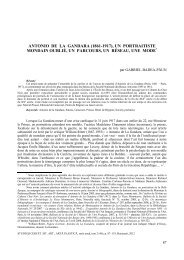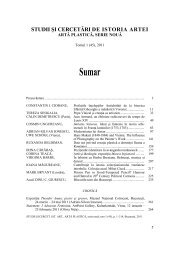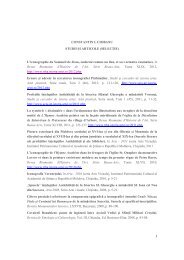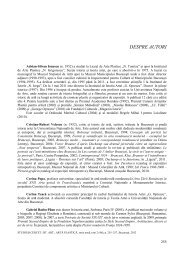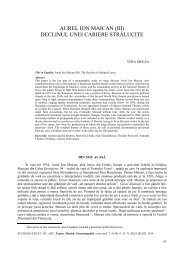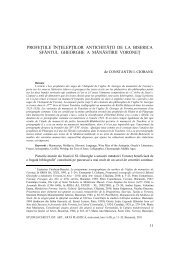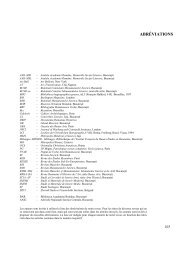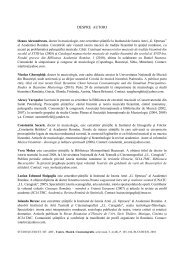observations on the technique of transcription - Institutul de Istoria Artei
observations on the technique of transcription - Institutul de Istoria Artei
observations on the technique of transcription - Institutul de Istoria Artei
You also want an ePaper? Increase the reach of your titles
YUMPU automatically turns print PDFs into web optimized ePapers that Google loves.
OBSERVATIONS ON THE TECHNIQUE OF TRANSCRIPTION<br />
(ΕΞHΓΗΣΙΣ) INTO THE NEW METHOD OF ANALYTICAL<br />
MUSIC NOTATION OF THE SUNDAY KOINONIKON<br />
OF THE 18 TH CENTURY<br />
NICOLAE GHEORGHIŢĂ<br />
Abstract<br />
The phenomen<strong>on</strong> <strong>of</strong> exegesis (εξήγησις) <strong>of</strong> Byzantine music and <strong>of</strong> transcribing <strong>the</strong> old musical settings<br />
into <strong>the</strong> New Method <strong>of</strong> analytical music notati<strong>on</strong> since <strong>the</strong> beginning <strong>of</strong> <strong>the</strong> 19 th century is <strong>on</strong>e <strong>of</strong> <strong>the</strong><br />
extremely disputed subjects am<strong>on</strong>gst musicologists. A true “apple <strong>of</strong> discord”, perhaps <strong>the</strong> practice <strong>of</strong><br />
translating or interpreting <strong>the</strong> Byzantine music semiographic system is <strong>the</strong> best example to <strong>de</strong>scribe <strong>the</strong><br />
totally irreducible mentality which has characterized and is still characterizing part <strong>of</strong> <strong>the</strong> researchers in<br />
<strong>the</strong> field with regards to this point. The discussi<strong>on</strong>s started from <strong>the</strong> difficulties in un<strong>de</strong>rstanding <strong>the</strong><br />
stenographic and mnemo-technical features <strong>of</strong> this notati<strong>on</strong> and from <strong>the</strong> fact that both <strong>the</strong> oral traditi<strong>on</strong><br />
and <strong>the</strong> written <strong>on</strong>e accredit <strong>the</strong> i<strong>de</strong>a that <strong>the</strong> motivic formulas (<strong>the</strong>seis) in <strong>the</strong> old Byzantine music<br />
notati<strong>on</strong> were semiographic units that focused <strong>on</strong> <strong>the</strong> melos or <strong>the</strong> real, truthful melody.<br />
As it is well known, <strong>the</strong> c<strong>on</strong>structi<strong>on</strong> system <strong>of</strong> <strong>the</strong> Byzantine melos and, implicitly, <strong>of</strong> <strong>the</strong> Sunday<br />
koin<strong>on</strong>ik<strong>on</strong>, is <strong>on</strong>e in which <strong>the</strong> basic unit is <strong>the</strong> <strong>the</strong>sis (<strong>the</strong> motivic formula) and <strong>the</strong> successi<strong>on</strong> <strong>of</strong><br />
<strong>the</strong>seis. Thus, I chose to study <strong>the</strong> exegesis <strong>technique</strong> for <strong>the</strong> Sunday koin<strong>on</strong>ik<strong>on</strong> in <strong>the</strong> 18 th century<br />
<strong>on</strong> basis <strong>of</strong> <strong>the</strong> formulaic character <strong>of</strong> this music and its relati<strong>on</strong> with <strong>the</strong> psalm text. This analysis<br />
method is known as regressive collati<strong>on</strong>s (ἀναδροµικός παραλληλισµός), i.e. starting from <strong>the</strong><br />
received traditi<strong>on</strong> and going back, step by step, until reaching <strong>the</strong> medieval sources.<br />
The current study presents <strong>the</strong> c<strong>on</strong>clusi<strong>on</strong>s regarding <strong>the</strong> translati<strong>on</strong> (interpretati<strong>on</strong>) <strong>technique</strong> in <strong>the</strong><br />
New Semiography <strong>of</strong> <strong>the</strong> eleven most important formulas (<strong>the</strong>seis) existent in <strong>the</strong> Sunday koin<strong>on</strong>ika<br />
during <strong>the</strong> 18 th century, beginning with <strong>the</strong> 42 Sunday creati<strong>on</strong>s <strong>of</strong> Daniel Protopsaltes (8 koin<strong>on</strong>ika),<br />
Petros Lampadarios Pelop<strong>on</strong>nesios (26 koin<strong>on</strong>ika) and Petros Byzantios (8 koin<strong>on</strong>ika), in <strong>the</strong><br />
“interpretati<strong>on</strong>s” <strong>of</strong>fered by <strong>the</strong> “fa<strong>the</strong>rs” <strong>of</strong> <strong>the</strong> New Semiography in <strong>the</strong> beginning <strong>of</strong> <strong>the</strong> 19 th<br />
century: Gregorios Protopsaltes (1778–1821) and Chourmouzios Chartophylax (1770–1840).<br />
Keywords: Church music, Byzantine chant, Sunday koin<strong>on</strong>ik<strong>on</strong>, New semiography, Old system,<br />
exegesis (εξήγησις) <strong>of</strong> Byzantine music, motivic formulas (<strong>the</strong>seis).<br />
1. INTRODUCTION<br />
The phenomen<strong>on</strong> <strong>of</strong> exegesis (ἐξήγησις) <strong>of</strong> Byzantine music and <strong>of</strong> transcribing <strong>the</strong> old musical settings into<br />
<strong>the</strong> New Method <strong>of</strong> analytical music notati<strong>on</strong> since <strong>the</strong> beginning <strong>of</strong> <strong>the</strong> 19 th century is <strong>on</strong>e <strong>of</strong> <strong>the</strong> extremely<br />
disputed subjects am<strong>on</strong>gst musicologists. A true “apple <strong>of</strong> discord”, perhaps <strong>the</strong> practice <strong>of</strong> translating or<br />
interpreting <strong>the</strong> Byzantine music semiographic system is <strong>the</strong> best example to <strong>de</strong>scribe <strong>the</strong> totally irreducible<br />
mentality which has characterized and is still characterizing part <strong>of</strong> <strong>the</strong> researchers in <strong>the</strong> field with regards to this<br />
point. 1<br />
1 See, especially, <strong>the</strong> famous comment <strong>of</strong> H. J. W. TILLYARD (“The Stenographic Theory <strong>of</strong> Byzantine Music”, in: Laudate 2,<br />
4 (1924), 216–225, and Laudate 3, 9 (1925), 28–32; IDEM, “The Stenographic Theory <strong>of</strong> Byzantine Music”, in: Byzantinische<br />
Zeitschrift 25 (1925), 333–338 to <strong>the</strong> book <strong>of</strong> K. PSACHOS, Ἡ Παρασηµαντικὴ τῆς Βυζαντινῆς Μουσικῆς, A<strong>the</strong>ns (1917). See also<br />
H. J. W. TILLYARD, “The Mo<strong>de</strong>s in Byzantine Music”, in: Annual <strong>of</strong> <strong>the</strong> British School <strong>of</strong> A<strong>the</strong>ns 22 (1916–1917 and 1917–1918),<br />
147; IDEM, Handbook <strong>of</strong> <strong>the</strong> Middle Byzantine Notati<strong>on</strong>, M<strong>on</strong>umenta Musicae Byzantiae, Subsidia 1. Copenhagen (1935),<br />
STUDII ŞI CERCET. IST. ART., Teatru, Muzică, Cinematografie, serie nouă, T. 4 (48), P. 9–26, BUCUREŞTI, 2010<br />
9
The discussi<strong>on</strong>s started from <strong>the</strong> difficulties in un<strong>de</strong>rstanding <strong>the</strong> stenographic and mnemo-technical<br />
features <strong>of</strong> this notati<strong>on</strong> and from <strong>the</strong> fact that both <strong>the</strong> oral traditi<strong>on</strong> and <strong>the</strong> written <strong>on</strong>e accredit <strong>the</strong> i<strong>de</strong>a that<br />
<strong>the</strong> motivic formulas (<strong>the</strong>seis) in <strong>the</strong> old Byzantine music notati<strong>on</strong> were semiographic units that focused <strong>on</strong><br />
<strong>the</strong> melos or <strong>the</strong> real, truthful melody.<br />
For more than five centuries, <strong>the</strong> practice <strong>of</strong> exegesis was inscribed in <strong>the</strong> Byzantine music codices<br />
through two terms: ἑρµηνεία (interpretati<strong>on</strong>) or ἐξήγησις (exegesis) and ἀνάλησις (writing/analytic<br />
transcripti<strong>on</strong>). It is worth menti<strong>on</strong>ing that while <strong>the</strong> two terms (ἑρµηνεία and ἐξήγησις) have <strong>the</strong> same<br />
meaning, <strong>the</strong> term ἀνάλησις refers especially to <strong>the</strong> analytical transcripti<strong>on</strong>s <strong>of</strong> <strong>the</strong> old music repertoires into<br />
<strong>the</strong> New Method. 2<br />
10<br />
2. METHODOLOGY<br />
The Sunday koin<strong>on</strong>ik<strong>on</strong> (Αἰνεῖτε τὸν Κύριον ἐκ τῶν οὐρανῶν, ἁλληλούϊα, Praise <strong>the</strong> Lord from <strong>the</strong><br />
heavens, Psalm 148.1) is <strong>on</strong>e <strong>of</strong> <strong>the</strong> most important classes <strong>of</strong> compositi<strong>on</strong>s <strong>of</strong> <strong>the</strong> papadic idiom (melos). It<br />
is also <strong>the</strong> creati<strong>on</strong> mostly represented in <strong>the</strong> manuscript traditi<strong>on</strong> at <strong>the</strong> level <strong>of</strong> this category <strong>of</strong> chants. 3<br />
As it is well known, <strong>the</strong> c<strong>on</strong>structi<strong>on</strong> system <strong>of</strong> <strong>the</strong> Byzantine melos and, implicitly, <strong>of</strong> <strong>the</strong> Sunday<br />
koin<strong>on</strong>ik<strong>on</strong>, is <strong>on</strong>e in which <strong>the</strong> basic unit is <strong>the</strong> <strong>the</strong>sis (<strong>the</strong> motivic formula) and <strong>the</strong> successi<strong>on</strong> <strong>of</strong> <strong>the</strong>seis. 4<br />
Thus, I chose to study <strong>the</strong> exegesis <strong>technique</strong> for <strong>the</strong> Sunday koin<strong>on</strong>ik<strong>on</strong> in <strong>the</strong> 18 th century <strong>on</strong> basis <strong>of</strong> <strong>the</strong><br />
formulaic character <strong>of</strong> this music and its relati<strong>on</strong> with <strong>the</strong> psalm text. 5 This analysis method is known as<br />
especially p. 15. An excellent book regarding <strong>the</strong> extremely complex problematic <strong>of</strong> Byzantine Music transcripti<strong>on</strong> is by Maria<br />
ALEXANDRU, ΕΞΗΓΗΣΕΙΣ ΚΑΙ ΜΕΤΑΓΡΑΦΕΣ ΤΗΣ ΒΥΖΑΝΤΙΝΗΣ ΜΟΥΣΙΚΗΣ. Σύντοµη εισαγωγή στον προβληµατισµό τους.<br />
University Studio Press, Thessal<strong>on</strong>iki (2010). See also A. LINGAS, “Performance Practice and <strong>the</strong> Politics <strong>of</strong> Transcribing Byzantine<br />
Chant”, in: Le chant byzantin: état <strong>de</strong>s recherches. Actes du colloque tenu du 12 au 15 décembre 1996 à l’Abbaye <strong>de</strong> Royaum<strong>on</strong>t,<br />
Acta Musicae Byzantinae 6 (2003), 56–76.<br />
2 The terminology <strong>de</strong>fining <strong>the</strong> last stage <strong>of</strong> <strong>the</strong> Byzantine music circulates with several <strong>de</strong>nominati<strong>on</strong>s: New Method, New<br />
System, Method <strong>of</strong> <strong>the</strong> New System, New Way (<strong>of</strong> writing down <strong>the</strong> music), Analytical Method <strong>of</strong> Byzantine Music, Chrysantine<br />
Theory and Notati<strong>on</strong>. For <strong>the</strong> Byzantine music notati<strong>on</strong>s before <strong>the</strong> Chrysantine Reform <strong>of</strong> 1814, <strong>the</strong> terminology is <strong>the</strong> following:<br />
Old Method, Old Way, Old System, Synoptic Manner <strong>of</strong> Writing <strong>of</strong> Byzantine Music, Old Method <strong>of</strong> <strong>the</strong> Synoptic (i.e. stenographic)<br />
Notati<strong>on</strong>. See GR. TH. STATHES, “An Analysis <strong>of</strong> <strong>the</strong> Sticher<strong>on</strong> Τὸν ἥλιον κρύψαντα by Germanos bishop <strong>of</strong> New Patras [The Old<br />
“Synoptic” and <strong>the</strong> New “Analytical” Method <strong>of</strong> Byzantine Notati<strong>on</strong>]”, in: Studies in Eastern Chant 4 (1979), 180.<br />
3 The liturgical–musical problem <strong>of</strong> <strong>the</strong> koin<strong>on</strong>ika (not <strong>on</strong>ly <strong>the</strong> Sunday <strong>on</strong>e) during <strong>the</strong> Byzantine period was <strong>de</strong>bated by<br />
H. LECLERQ, “Communi<strong>on</strong>”, Dicti<strong>on</strong>naire d’archéologie chrétienne et <strong>de</strong> liturgie 3/II. Paris 1914, cols. 2427–2435; K. LEVY, “The<br />
Byzantine Communi<strong>on</strong> Cycle and its Slavic Counterpart”, in: Actes du XII c<strong>on</strong>grès internati<strong>on</strong>al <strong>de</strong>s étu<strong>de</strong>s byzantines, Ochri<strong>de</strong><br />
(1961), col. 2, Belgra<strong>de</strong> (1964), 571–574; H. BRESLICH-ERICKSON, “The Communi<strong>on</strong> Hymn <strong>of</strong> <strong>the</strong> Byzantine Liturgy <strong>of</strong> <strong>the</strong><br />
Presanctified Gifts”, Studies in Eastern Chant 3 (1973), 51–73; N. K. MORAN, The Ordinary Chants <strong>of</strong> <strong>the</strong> Byzantine Mass, vol. I<br />
(Investigati<strong>on</strong>s), Hamburger Beiträge zur Musikwissenschaft, Begrün<strong>de</strong>t v<strong>on</strong> Georg v<strong>on</strong> Da<strong>de</strong>lsen, Herausgegeben v<strong>on</strong> C<strong>on</strong>stantin<br />
Floros, Band 12, Verlagt <strong>de</strong>r Musikalienhandlung, Karl Dieter Wagner, Hamburg (1975), 170–174; D. E. CONOMOS, “Psalmody and<br />
Communi<strong>on</strong> Cycle”, in: Saint Vladimir’s Theological Quarterly, vol. 25 (1981), no. 1, 35–62 and no. 2, 95–123; IDEM, “Communi<strong>on</strong><br />
Chants in Magna Graecia and Byzantium”, Journal <strong>of</strong> <strong>the</strong> American Musicological Society 33 (1980), 241–263; IDEM, The Late<br />
Byzantine and Slav<strong>on</strong>ic Communi<strong>on</strong> Cycle: Liturgy and Music, Dumbart<strong>on</strong> Oaks Studies 21 (Washingt<strong>on</strong>, D.C., 1985);<br />
R.F. TAFT, S. J., “Byzantine Communi<strong>on</strong> Rites” I, in: Orientalia Christiana Periodica 65 (1999), 307–345 and II, in: Orientalia<br />
Christiana Periodica 67 (2001), 275–352; TH. SCHATTAUER, “The Koin<strong>on</strong>ic<strong>on</strong> <strong>of</strong> <strong>the</strong> Byzantine Liturgy: An Historical Study”, in:<br />
Orientalia Christiana Periodica 49 (1983), 91–129; S. HARRIS, The Communi<strong>on</strong> Chant <strong>of</strong> <strong>the</strong> Thirteenth-Century Byzantine<br />
Asmatik<strong>on</strong>, în: Music Archive Publicati<strong>on</strong>s, A1, Amsterdam, 1999; R. TAFT, S.J., A History <strong>of</strong> <strong>the</strong> Liturgy <strong>of</strong> St. John Chrysostom,<br />
vol. 5, Rome (2000). CHR. TROELSGÅRD, “Koinōnik<strong>on</strong>”, in: The New Grove Dicti<strong>on</strong>ary <strong>of</strong> Music and Musicians, edited by Stanley<br />
Sadie, ( 2 2002), vol. 13, 744–745. The musical analysis <strong>of</strong> <strong>the</strong> Sunday koin<strong>on</strong>ik<strong>on</strong> during <strong>the</strong> Post-Byzantine period can be studied in:<br />
N. GHEORGHIŢĂ, “The Kaloph<strong>on</strong>ic Idiom in <strong>the</strong> Sec<strong>on</strong>d Half <strong>of</strong> <strong>the</strong> XVIII th Century. The Koin<strong>on</strong>ika Αἰνεῖτε τὸν Κύριον in <strong>the</strong> first<br />
au<strong>the</strong>ntic mo<strong>de</strong>”, in: Acta Musicae Byzantinae 5 (2003), 45–50; IDEM, Chin<strong>on</strong>icul duminical în perioada post-bizantină (1453–1821).<br />
Liturgică şi muzică, Bucharest (2009); IDEM, “The Structure <strong>of</strong> Sunday Koin<strong>on</strong>ik<strong>on</strong> in <strong>the</strong> Post–Byzantine Era”, in: Traditi<strong>on</strong> and<br />
Innovati<strong>on</strong> in <strong>the</strong> Late and Post-byzantine Chant, Acta <strong>of</strong> <strong>the</strong> C<strong>on</strong>gress Held at Hernen Castle, <strong>the</strong> Ne<strong>the</strong>rlands, in April 2005 (ed. G.<br />
WOLFRAM). Leuven 2008, 331–355.<br />
4 The <strong>de</strong>finiti<strong>on</strong> <strong>of</strong> <strong>the</strong> term <strong>the</strong>sis can be studied in Manuel Chrysaphes <strong>the</strong> Lampadarios: On <strong>the</strong> Theory <strong>of</strong> <strong>the</strong> Art <strong>of</strong><br />
Chanting and <strong>on</strong> Certain Err<strong>on</strong>eous Views That Some Hold About it (Edited from Mount Athos, Ivir<strong>on</strong> M<strong>on</strong>astery MS 1120 [July,<br />
1458]). Text, Translati<strong>on</strong> and Commentary by D.E. CONOMOS, Corpus Scriptorum <strong>de</strong> Re Musica 2, Wien (1985), 41.<br />
5 For an in <strong>de</strong>pth analysis, see GHEORGHIŢĂ, “The kaloph<strong>on</strong>ic Idiom...”; IDEM, Chin<strong>on</strong>icul duminical..., 127–229. For <strong>the</strong><br />
17 th century, see IDEM, Chin<strong>on</strong>icul duminical..., 230–253.
egressive collati<strong>on</strong>s (ἀναδροµικός παραλληλισµός), i.e. starting from <strong>the</strong> received traditi<strong>on</strong> and going back,<br />
step by step, until reaching <strong>the</strong> medieval sources. 6<br />
The current study presents <strong>the</strong> c<strong>on</strong>clusi<strong>on</strong>s regarding <strong>the</strong> translati<strong>on</strong> (interpretati<strong>on</strong>) <strong>technique</strong> in <strong>the</strong><br />
“New Semiography” <strong>of</strong> <strong>the</strong> eleven most important formulas (<strong>the</strong>seis) existent in <strong>the</strong> Sunday koin<strong>on</strong>ika during<br />
<strong>the</strong> 18 th century, beginning with <strong>the</strong> 42 Sunday creati<strong>on</strong>s <strong>of</strong> Daniel Protopsaltes (8 koin<strong>on</strong>ika), Petros<br />
Lampadarios Pelop<strong>on</strong>nesios (26 koin<strong>on</strong>ika) and Petros Byzantios (8 koin<strong>on</strong>ika), in <strong>the</strong> “interpretati<strong>on</strong>s”<br />
<strong>of</strong>fered by <strong>the</strong> “fa<strong>the</strong>rs” <strong>of</strong> <strong>the</strong> New Semiography in <strong>the</strong> beginning <strong>of</strong> <strong>the</strong> 19 th century: Gregorios Protopsaltes<br />
(1778–1821) and Chourmouzios Chartophylax (1770–1840).<br />
The manuscripts and <strong>the</strong> imprinted editi<strong>on</strong>s also used for <strong>the</strong> study were <strong>the</strong> following: Gr. MS 955<br />
(Παπαδικὴ νέα, τόµος Β', 18 th c. [end] – 19 th c. [beg.], ff. 97r – 129r, Library <strong>of</strong> <strong>the</strong> Romanian Aca<strong>de</strong>my in<br />
Bucharest); MS 735 (Ἀνθολογία ἐξηγήσεων, dated 1822, ff. 87r – 104v, EBE (ΜΠΤ) autograph Gregorios<br />
Protopsaltes?); MS 1289 (Ἀνθολογία, ff. 311r – 351v, dated 1802, M<strong>on</strong>astery <strong>of</strong> Vatopedi – Mount Athos,<br />
autograph Mathaios Ephesios Vatopedinos); MS 1458 (Πανδέκτη, ff. 398r – 440v, 19 th c. [beg.], M<strong>on</strong>astery<br />
<strong>of</strong> Vatopedi – Mount Athos, autograph Apostolos K<strong>on</strong>stas Chios); Gr. MS 4920 (Ἀνθολογία, New Notati<strong>on</strong>,<br />
19 th c. [first half], ff. 96r – 146v, Nati<strong>on</strong>al Library in Bucharest); Ταµεῖον Ἀνθολογίας (C<strong>on</strong>stantinople,<br />
1824), Ταµεῖον Ἀνθολογίας (C<strong>on</strong>stantinople, 1854).<br />
3. ANALYSIS<br />
3.1. CONCLUSIONS 1<br />
The chapter C<strong>on</strong>clusi<strong>on</strong>s 1 presents <strong>the</strong> examples which have <strong>the</strong> value <strong>of</strong> a norm, i.e. <strong>of</strong> a rule. The<br />
standard formulas and not <strong>the</strong> excepti<strong>on</strong>s were taken into account.<br />
FORMULA I: THESIS WITH KYLISMA<br />
The <strong>the</strong>sis including <strong>the</strong> great cheir<strong>on</strong>omic sign <strong>of</strong> kylisma is <strong>on</strong>e <strong>of</strong> <strong>the</strong> most representative formulas <strong>of</strong> <strong>the</strong><br />
papadic melos during <strong>the</strong> 18 th century. Its presence is exclusively related to <strong>the</strong> melos <strong>of</strong> <strong>the</strong> first part (Αἰνεῖτε<br />
τὸν Κύριον ἐκ τῶν οὐρανῶν), marking <strong>the</strong> final ca<strong>de</strong>nce segments <strong>of</strong> Αἰνεῖτε and <strong>the</strong> hemistiches (<strong>the</strong> first<br />
hemistich [Αἰνεῖτε τὸν Κύριον], <strong>the</strong> sec<strong>on</strong>d hemistich [ἐκ τῶν οὐρανῶν]). In this case, its musical pr<strong>of</strong>ile<br />
acquires <strong>the</strong> characteristic features for each mo<strong>de</strong> and <strong>the</strong> modal stage <strong>the</strong> ca<strong>de</strong>nce is building up. Most<br />
times, it functi<strong>on</strong>s <strong>on</strong> basis <strong>of</strong> <strong>the</strong> principle <strong>of</strong> pentachord transpositi<strong>on</strong>.<br />
In <strong>the</strong> n<strong>on</strong>-ca<strong>de</strong>nce c<strong>on</strong>text, <strong>the</strong> <strong>the</strong>sis with kylisma loses its melismatic effect. It is worth menti<strong>on</strong>ing<br />
that Mo<strong>de</strong> IV Plagal and Mo<strong>de</strong> III (which takes over <strong>the</strong> scale from <strong>the</strong> Mo<strong>de</strong> IV Plagal), have <strong>the</strong> modulator<br />
inflecti<strong>on</strong> (a short transiti<strong>on</strong>) towards <strong>the</strong> sec<strong>on</strong>d mo<strong>de</strong> inserted organically. In both cases <strong>the</strong> chromatic<br />
intenti<strong>on</strong> aims at <strong>the</strong> fifth step <strong>of</strong> <strong>the</strong> mo<strong>de</strong>, towards <strong>the</strong> final part <strong>of</strong> <strong>the</strong> hemistiches.<br />
From <strong>the</strong> typology <strong>of</strong> <strong>the</strong> <strong>the</strong>sis with kylisma, we <strong>on</strong>ly retain <strong>the</strong> ca<strong>de</strong>nce c<strong>on</strong>text:<br />
1. apostrophoi syn<strong>de</strong>smoi (or any o<strong>the</strong>r <strong>de</strong>scen<strong>de</strong>nt diastematic sign, sometimes without/with diple,<br />
klasma) supported <strong>on</strong> bareia – oxeia – dyo-kentemata – gorg<strong>on</strong> – petaste – apostrophos – elaphr<strong>on</strong><br />
with apo<strong>de</strong>rma (Table 1: Formula I – 1);<br />
2. apostrophos (or is<strong>on</strong>) with klasma (or without it) supported <strong>on</strong> bareia – aporrhoë – petaste –<br />
apostrophos – is<strong>on</strong> (elaphr<strong>on</strong>) with apo<strong>de</strong>rma (diple) (Table 1: Formula I – 2);<br />
3. apostrophos with klasma supported <strong>on</strong> bareia – apostrophos – petaste – apostrophos – is<strong>on</strong> with diple<br />
(or apo<strong>de</strong>rma) (Table 1: Formula I – 3);<br />
4. is<strong>on</strong> (apostrophos or ano<strong>the</strong>r diastematic sign) with/without klasma (sometimes with antikenoma)<br />
supported <strong>on</strong> bareia – apostrophos – is<strong>on</strong> supported <strong>on</strong> petaste – apostrophos – elaphr<strong>on</strong> with<br />
apo<strong>de</strong>rma (Table 1: Formula I – 4).<br />
In all <strong>the</strong> four situati<strong>on</strong>s menti<strong>on</strong>ed above, <strong>the</strong> kylisma is positi<strong>on</strong>ed un<strong>de</strong>r <strong>the</strong> neumatic combinati<strong>on</strong>.<br />
6 PSACHOS, Ἡ παρασηµαντική, p. 76; See also M. ALEXANDRU, “The Palaeography <strong>of</strong> Byzantine Music: a brief introducti<strong>on</strong><br />
with some preliminary remarks <strong>on</strong> musical palimpsests”, in: El palimsesto grecolatino como fenómeno librario y textual (Ed.<br />
Á. ESCOBAR), Zaragoza (2006), 116.<br />
11
FORMULA II: THESIS WITH PARAKALESMA<br />
The Parakalesma appears exclusively in part I <strong>of</strong> <strong>the</strong> Sunday koin<strong>on</strong>ik<strong>on</strong> (mainly in hemistich 1 [Αἰνεῖτε τὸν<br />
Κύριον]) and <strong>on</strong>ly in <strong>the</strong> mo<strong>de</strong>s I, III, I plagal and IV plagal. In most <strong>of</strong> <strong>the</strong> situati<strong>on</strong>s we encounter it, <strong>the</strong><br />
formula is placed after a ca<strong>de</strong>nce <strong>of</strong> <strong>the</strong> following type: , sometimes in sequential c<strong>on</strong>structi<strong>on</strong>,<br />
ei<strong>the</strong>r at <strong>the</strong> beginning <strong>of</strong> <strong>the</strong> sec<strong>on</strong>d hemistich, or at <strong>the</strong> beginning <strong>of</strong> τὸν Κύριον (Table 2: Formula II).<br />
13
FORMULA III: THESIS WITH PARAKLETIKE<br />
In <strong>the</strong> examined chants, <strong>the</strong> parakletike is inserted in different neumatic groupings, equally in papadic and in<br />
heirmologic melos (part three – kratema), that is in <strong>the</strong> three secti<strong>on</strong>s <strong>of</strong> <strong>the</strong> piece. Being present in <strong>the</strong> whole<br />
Byzantine modal system, this cheir<strong>on</strong>omic sign <strong>de</strong>termines a melody which varies <strong>de</strong>pending <strong>on</strong> <strong>the</strong> step <strong>the</strong><br />
ca<strong>de</strong>nce is performed <strong>on</strong> and <strong>on</strong> its importance in <strong>the</strong> mo<strong>de</strong> hierarchy, but also <strong>on</strong> <strong>the</strong> movement (tempo) <strong>of</strong><br />
each <strong>on</strong>e <strong>of</strong> <strong>the</strong> chant parts (papadic or heirmologic). Eventually, <strong>the</strong> instances in which <strong>the</strong> parakletike is<br />
inserted are <strong>the</strong> following:<br />
1. In <strong>the</strong> combinati<strong>on</strong>s with <strong>the</strong> <strong>the</strong>sis c<strong>on</strong>sisting <strong>of</strong> apostrophos (supported or not <strong>on</strong> <strong>the</strong> mikri bareia),<br />
followed by olig<strong>on</strong> with diple, <strong>the</strong> parakletike forms <strong>the</strong> ample melodic c<strong>on</strong>structi<strong>on</strong> that starts at <strong>the</strong><br />
beginning <strong>of</strong> <strong>the</strong> koin<strong>on</strong>ik<strong>on</strong>, a truly jubilatory structure very characteristic <strong>of</strong> <strong>the</strong> papadic idiom. In<br />
<strong>the</strong> corpus <strong>of</strong> <strong>the</strong> 42 koin<strong>on</strong>ika <strong>the</strong> “opening” phrase is signalled in <strong>the</strong> mo<strong>de</strong>s II, III and I plagal<br />
(Table 3: Formula III – 1);<br />
2. a) In <strong>the</strong> is<strong>on</strong> combinati<strong>on</strong> (or any o<strong>the</strong>r intervallic sign) – <strong>the</strong> dyo-kentemata, supported <strong>on</strong> petaste –<br />
apostrophos, <strong>the</strong> parakletike is inserted un<strong>de</strong>r <strong>the</strong>m and it is present in all <strong>the</strong> mo<strong>de</strong>s, except in barys.<br />
This neumatic grouping is used as a formula preceding <strong>the</strong> final ca<strong>de</strong>nces <strong>of</strong> Αἰνεῖτε or <strong>of</strong> <strong>the</strong><br />
hemistiches. Out <strong>of</strong> <strong>the</strong> multitu<strong>de</strong> <strong>of</strong> examples exclusively bel<strong>on</strong>ging to part I, and which are<br />
presented in <strong>the</strong> translati<strong>on</strong> to <strong>the</strong> New Semiography in a unique versi<strong>on</strong>, Mo<strong>de</strong> IV Plagal proposes a<br />
sigle situati<strong>on</strong> in which <strong>the</strong> formula is inserted with <strong>the</strong> same melos and at <strong>the</strong> beginning <strong>of</strong> <strong>the</strong><br />
kratema (<strong>the</strong> sec<strong>on</strong>d part) (Table 3: Formula III – 2a);<br />
b) The combinati<strong>on</strong> parakletike – oxeia with kentema and tromik<strong>on</strong> followed by two apostrophoi is<br />
inscribed in <strong>the</strong> pattern <strong>of</strong> <strong>the</strong> same formula prefacing <strong>the</strong> final ca<strong>de</strong>nce <strong>of</strong> <strong>the</strong> hemistiches (Table 3:<br />
Formula III – 2b);<br />
3. In <strong>the</strong> pelast<strong>on</strong> combinati<strong>on</strong> <strong>of</strong> two or three apostrophoi and <strong>the</strong> tromik<strong>on</strong> placed un<strong>de</strong>r <strong>the</strong> sec<strong>on</strong>d<br />
apostrophos, <strong>the</strong> great af<strong>on</strong>os sign is positi<strong>on</strong>ed over <strong>the</strong> <strong>the</strong>sis. We can encounter <strong>the</strong> formula in all<br />
<strong>the</strong> eight mo<strong>de</strong>s, both in part II (kratema) – where <strong>the</strong> secti<strong>on</strong>’s beginning is preferred, mainly in<br />
sequential successi<strong>on</strong>s, but also insi<strong>de</strong> it or at its end – as well as in <strong>the</strong> o<strong>the</strong>r two parts. It worth<br />
menti<strong>on</strong>ing that its melody varies <strong>de</strong>pending <strong>on</strong> its bel<strong>on</strong>ging to <strong>the</strong> papadic or heirmologic<br />
movement (Table 3: Formula III – 3).<br />
14
FORMULA IV: THESIS WITH EPEGERMA<br />
The formula is specific both to <strong>the</strong> text melody and to <strong>the</strong> kratema. The reduced number <strong>of</strong> instances where<br />
<strong>the</strong> epegerma is present as well as its equivocal translati<strong>on</strong> to <strong>the</strong> New Method <strong>of</strong>fered by <strong>the</strong> Three<br />
Teachers, do not allow us to formulate a <strong>de</strong>finitive c<strong>on</strong>clusi<strong>on</strong> <strong>on</strong> <strong>the</strong> stenographic functi<strong>on</strong> <strong>of</strong> this <strong>the</strong>sis.<br />
Ei<strong>the</strong>r <strong>the</strong> formula is inserted in <strong>the</strong> final ca<strong>de</strong>nce point <strong>of</strong> hemistich 2, or in part II, its melos is still ample,<br />
<strong>de</strong>spite <strong>the</strong> idiom differences. 7 This is probably due to <strong>the</strong> c<strong>on</strong>clusive intenti<strong>on</strong> given by <strong>the</strong> two haplai<br />
present un<strong>de</strong>r <strong>the</strong> olig<strong>on</strong> or due to <strong>the</strong> inserti<strong>on</strong> <strong>of</strong> <strong>the</strong> <strong>the</strong>sis in <strong>the</strong> beginning <strong>of</strong> sec<strong>on</strong>d part. When it is<br />
inserted in <strong>the</strong> kratema, <strong>the</strong> formula provi<strong>de</strong>s <strong>the</strong> beginning <strong>of</strong> <strong>the</strong> secti<strong>on</strong>; when it is toge<strong>the</strong>r with <strong>the</strong> <strong>the</strong>sis<br />
<strong>of</strong> <strong>the</strong> lygisma, it can build up <strong>the</strong> whole sec<strong>on</strong>d secti<strong>on</strong>.<br />
The Thesis with epegerma has <strong>the</strong> following neumatic pr<strong>of</strong>ile: epegerma positi<strong>on</strong>ed un<strong>de</strong>r <strong>the</strong> <strong>the</strong>sis<br />
c<strong>on</strong>sisting <strong>of</strong> apostrophos (or any o<strong>the</strong>r diatematic sign) supported <strong>on</strong> bareia, with/without klasma, dyokentemata<br />
with/without gorg<strong>on</strong>, elaphr<strong>on</strong>, homal<strong>on</strong>, olig<strong>on</strong> with apo<strong>de</strong>rma (diple) (Table 4: Formula IV).<br />
FORMULA V<br />
The formula V bel<strong>on</strong>gs exclusively to secti<strong>on</strong> I 8 and is given in three combinati<strong>on</strong>s:<br />
1. olig<strong>on</strong> with/without klasma – aporrhoë supported <strong>on</strong> small bareia ([mikri bareia] written in red) –<br />
olig<strong>on</strong> – apostrophos with/without apo<strong>de</strong>rma (or diple). The <strong>the</strong>sis can be accompanied by heter<strong>on</strong><br />
[parakalesma] written in red (Table 5: Formula V – 1);<br />
2. olig<strong>on</strong> (or any o<strong>the</strong>r diastematic sign) with kratema – aporrhoë – olig<strong>on</strong> (oxeia) – apostrophos<br />
with/without apo<strong>de</strong>rma (or diple). The <strong>the</strong>sis can be accompanied by heter<strong>on</strong> [parakalesma] written<br />
in red (Table 5: Formula V – 2);<br />
3. <strong>the</strong> last combinati<strong>on</strong> is basically <strong>the</strong> „formula 1” presented in sequential successi<strong>on</strong>. In <strong>the</strong> New<br />
Notati<strong>on</strong>, <strong>the</strong> <strong>the</strong>sis forms a melodic unit, in<strong>de</strong>pen<strong>de</strong>nt from <strong>the</strong> principle mo<strong>de</strong>l-sequence <strong>of</strong> <strong>the</strong> Old<br />
Notati<strong>on</strong>, but in which we find elements that are comm<strong>on</strong> to both formulas („1” and „2”)(Table 5:<br />
Formula V – 3).<br />
7 The few examples, in which <strong>the</strong> melodic line is obviously diminished, bel<strong>on</strong>g to <strong>the</strong> third mo<strong>de</strong> (insi<strong>de</strong> <strong>the</strong> kratema – third<br />
mo<strong>de</strong>, Daniel Protopsaltes) and first mo<strong>de</strong> (Daniel Protopsaltes).<br />
8 There is also <strong>on</strong>e case in which <strong>the</strong> formula is inserted at <strong>the</strong> beginning <strong>of</strong> <strong>the</strong> kratema (Daniel Protopsaltes, Mo<strong>de</strong> I Plagal).<br />
16
FORMULA VI: THESIS WITH ARGOSYNTHETON/GORGOSYNTHETON<br />
The analysis <strong>of</strong> <strong>the</strong> Sunday koin<strong>on</strong>ik<strong>on</strong> repertoire in <strong>the</strong> 18 th century proves that <strong>the</strong> two formulas are<br />
exclusively part <strong>of</strong> <strong>the</strong> text melody. The most surprising c<strong>on</strong>clusi<strong>on</strong> is that, <strong>de</strong>spite bel<strong>on</strong>ging to <strong>the</strong> papadic<br />
idiom and having all <strong>the</strong> arguments to <strong>de</strong>velop ample melodic lines, <strong>the</strong> two formulas are totally ignored by<br />
<strong>the</strong> Three Teachers.<br />
The <strong>the</strong>seis in which <strong>the</strong> signs argosyn<strong>the</strong>t<strong>on</strong>/gorgosyn<strong>the</strong>t<strong>on</strong> are involved, are <strong>the</strong> following:<br />
1. olig<strong>on</strong> – apostrophos – olig<strong>on</strong> – apostrophos with argosyn<strong>the</strong>t<strong>on</strong>/gorgosyn<strong>the</strong>t<strong>on</strong> (Table 6: Formula<br />
VI). Excepti<strong>on</strong>ally, this formula can also be encountered in sequential c<strong>on</strong>text, and its melody can be<br />
recognised in both semiographies;<br />
2. <strong>de</strong>scen<strong>de</strong>nt fourth – oxeia with/without gorg<strong>on</strong> – elaphr<strong>on</strong> with klasma – argosyn<strong>the</strong>t<strong>on</strong> (Table 6:<br />
Formula VI).<br />
18
FORMULA VII: THESIS WITH XERON – KLASMA<br />
All <strong>the</strong> examples in which xer<strong>on</strong>-klasma is involved bel<strong>on</strong>g to part I 9 , more precisely to <strong>the</strong> sec<strong>on</strong>d segment<br />
<strong>of</strong> <strong>the</strong> first hemistich. Composers from C<strong>on</strong>stantinople prefer to insert this melodic figure ei<strong>the</strong>r accompanied<br />
by <strong>the</strong> direct complement “τον” and <strong>the</strong> first syllable from “Κύριον” („Κυ”), or <strong>on</strong> <strong>the</strong> vowel “υ”, which is<br />
marked at <strong>the</strong> end with <strong>the</strong> intercalated letter “χ”.<br />
The <strong>the</strong>sis un<strong>de</strong>r which xer<strong>on</strong>-klasma is inserted is as follows: petaste with piasma – aporrhoë – olig<strong>on</strong><br />
– apostrophos with tromik<strong>on</strong> – two c<strong>on</strong>secutive apostrophoi, usually <strong>the</strong> last syn<strong>de</strong>smoi (or apostrophos<br />
with/without diple) (Table 7: Formula VII).<br />
9 We menti<strong>on</strong> that <strong>the</strong> <strong>on</strong>ly example in which <strong>the</strong> xer<strong>on</strong>-klasma is inserted in <strong>the</strong> sec<strong>on</strong>d part, too (kratema), is <strong>of</strong>fered to us by<br />
Daniel Protopsaltes (barys). The sequential c<strong>on</strong>text, <strong>the</strong> idiom and probably <strong>the</strong> red colour <strong>the</strong> xer<strong>on</strong>-klasma is written in, <strong>de</strong>termines<br />
<strong>the</strong> loss <strong>of</strong> <strong>the</strong> stenographic dimensi<strong>on</strong> <strong>of</strong> <strong>the</strong> neuma.<br />
19
FORMULA VIII<br />
As it is characteristic <strong>of</strong> secti<strong>on</strong>s I and III, this formula is <strong>the</strong> articulating element, c<strong>on</strong>necting <strong>the</strong> great<br />
melodic figures <strong>of</strong> <strong>the</strong> Sunday koin<strong>on</strong>ik<strong>on</strong>. Prece<strong>de</strong>d by oxeia (olig<strong>on</strong>) with tromik<strong>on</strong> (strept<strong>on</strong>) with/without<br />
gorg<strong>on</strong>, this <strong>the</strong>sis is mostly followed by oxeia (olig<strong>on</strong>) with klasma supported <strong>on</strong> bareia – piasma –<br />
apostrophos.<br />
The formula can be found in all eight mo<strong>de</strong>s in <strong>the</strong> following typology that <strong>of</strong>fers two possibilities:<br />
1. is<strong>on</strong> with klasma – apostrophos – heter<strong>on</strong> (Table 8: Formula VIII – 1);<br />
2. is<strong>on</strong> with klasma – aporrhoë – heter<strong>on</strong> (Table VIII: Formula 8 – 2).<br />
20
FORMULA IX: THESIS WITH PIASMA<br />
The cheir<strong>on</strong>omic sign <strong>of</strong> <strong>the</strong> piasma is present in all eight mo<strong>de</strong>s according to <strong>the</strong> following typology:<br />
1. olig<strong>on</strong> (oxeia/is<strong>on</strong> or any o<strong>the</strong>r interval sign) with klasma – apostrophos – heter<strong>on</strong> [red] – piasma<br />
(Table 9: Formula IX – 1);<br />
2. olig<strong>on</strong> (oxeia/is<strong>on</strong> or any o<strong>the</strong>r interval sign) with klasma – two apostrophoi – heter<strong>on</strong> [red] –<br />
piasma (Table 9: Formula IX – 2);<br />
3. apostrophos with klasma – apostrophos – elaphr<strong>on</strong> and piasma placed un<strong>de</strong>r <strong>the</strong> <strong>the</strong>sis (Table 9:<br />
Formula IX – 3).<br />
The first example prece<strong>de</strong>s <strong>the</strong> ca<strong>de</strong>nce formula at <strong>the</strong> endings <strong>of</strong> <strong>the</strong> hemistiches; in combinati<strong>on</strong> with<br />
<strong>the</strong>se, it builds up <strong>the</strong> most ample and complex melodic structure <strong>of</strong> <strong>the</strong> entire piece.<br />
The sec<strong>on</strong>d formula appears in <strong>the</strong> n<strong>on</strong>-ca<strong>de</strong>nce c<strong>on</strong>text and has <strong>the</strong> role <strong>of</strong> c<strong>on</strong>necting <strong>the</strong> two<br />
structures, like a “ligament”.<br />
If <strong>the</strong> two <strong>the</strong>seis are especially characteristic <strong>of</strong> <strong>the</strong> text melody, <strong>the</strong> third formula is exclusively<br />
encountered in kratema, without stenographic value.<br />
21
FORMULA X: THESIS WITH SYNAGMA<br />
The fundamental characteristic <strong>of</strong> this formula is <strong>the</strong> fact that it bel<strong>on</strong>gs to part I, and more rarely, to part III<br />
<strong>of</strong> <strong>the</strong> Sunday koin<strong>on</strong>ik<strong>on</strong>. It can be found mainly in <strong>the</strong> middle <strong>of</strong> <strong>the</strong> piece, ei<strong>the</strong>r as ca<strong>de</strong>nce <strong>the</strong>sis <strong>of</strong><br />
hemistich 1 (see third mo<strong>de</strong>), or as incipit <strong>of</strong> hemistich 2 (see Mo<strong>de</strong> I Plagal), or inserted towards <strong>the</strong> end <strong>of</strong><br />
hemistich 1 (mo<strong>de</strong>s II, IV, IV plagal).<br />
The <strong>the</strong>sis with synagma c<strong>on</strong>sists <strong>of</strong> olig<strong>on</strong> (or any o<strong>the</strong>r interval sign) – apostrophos with/without<br />
klasma – aporrhoë – apostrophos – olig<strong>on</strong> with apo<strong>de</strong>rma/diple and synagma placed un<strong>de</strong>r <strong>the</strong> menti<strong>on</strong>ed<br />
neumatic combinati<strong>on</strong>. The instances encountered are presented in Table 10: Formula X.<br />
23
FORMULA XI: THESIS WITH PSEPHISTON – PARAKALESMA<br />
The last melodic figure studied in <strong>the</strong> Sunday koin<strong>on</strong>ik<strong>on</strong> repertoire in <strong>the</strong> 18 th century stays <strong>de</strong>voted to part<br />
I, being encountered <strong>on</strong>ly in mo<strong>de</strong>s III, I plagal, barys and IV plagal. The most important c<strong>on</strong>clusi<strong>on</strong> after<br />
studying <strong>the</strong> few examples in which psephist<strong>on</strong> – parakalesma is involved, especially in barys and IV plagal,<br />
shows that it is not a cheir<strong>on</strong>omic sign which is <strong>de</strong>termining in <strong>de</strong>veloping an ample melos, but – in our case<br />
– ra<strong>the</strong>r <strong>the</strong> ca<strong>de</strong>nce c<strong>on</strong>text. This last formula can be seen in Table 11: Formula XI.<br />
24
3.2. CONCLUSIONS 2<br />
Following <strong>the</strong> investigati<strong>on</strong> <strong>of</strong> <strong>the</strong> c<strong>on</strong>structi<strong>on</strong> mechanism <strong>of</strong> <strong>the</strong> Sunday koin<strong>on</strong>ika repertoire in <strong>the</strong> 18 th<br />
century, <strong>the</strong> c<strong>on</strong>clusi<strong>on</strong>s regarding <strong>the</strong> c<strong>on</strong>stitutive elements <strong>of</strong> <strong>the</strong> m<strong>on</strong>odic language are absolutely<br />
remarkable. The formula or <strong>the</strong> combinati<strong>on</strong> between <strong>the</strong> <strong>the</strong>sis and <strong>the</strong> cheir<strong>on</strong>omic sign that dominates <strong>the</strong><br />
<strong>the</strong>sis becomes <strong>the</strong> fundamental unit <strong>of</strong> c<strong>on</strong>structing <strong>the</strong> Byzantine melos, and is able to c<strong>on</strong>centrate whole<br />
phrases as well as to change <strong>the</strong> physiognomy <strong>de</strong>pending <strong>on</strong> four parameters which are as follows:<br />
1. The step <strong>of</strong> <strong>the</strong> infraoctaviant (diph<strong>on</strong>y, triph<strong>on</strong>y, tetraph<strong>on</strong>y, pentaph<strong>on</strong>y) or octaviant mo<strong>de</strong><br />
structure:<br />
This instance proves that <strong>the</strong> <strong>the</strong>sis is free to move, in most cases, insi<strong>de</strong> a tetrachord or pentachord <strong>of</strong> <strong>the</strong><br />
octoechal system. The transpositi<strong>on</strong> <strong>of</strong> <strong>the</strong> melodic fragment or formula is ma<strong>de</strong> ei<strong>the</strong>r through lex trochos or<br />
by what <strong>the</strong> Byzantine call µετάθεσις or mutati<strong>on</strong>/modulati<strong>on</strong>. This is <strong>the</strong> reas<strong>on</strong> why certain <strong>the</strong>seis are<br />
comm<strong>on</strong> to more than <strong>on</strong>e mo<strong>de</strong>. Also some <strong>of</strong> <strong>the</strong>se <strong>the</strong>seis are characteristic to certain mo<strong>de</strong>s and o<strong>the</strong>rs to<br />
o<strong>the</strong>r mo<strong>de</strong>s. Some <strong>of</strong> <strong>the</strong>m have ca<strong>de</strong>nce character (see for example <strong>the</strong>sis with kylisma), o<strong>the</strong>rs are<br />
characteristic for beginnings (<strong>the</strong>sis with parakletike), whereas o<strong>the</strong>rs have <strong>the</strong> functi<strong>on</strong> <strong>of</strong> a ligament.<br />
Never<strong>the</strong>less, all <strong>of</strong> <strong>the</strong>m <strong>de</strong>pend <strong>on</strong> <strong>the</strong> step <strong>the</strong> ca<strong>de</strong>nce is reached <strong>on</strong> and <strong>on</strong> its functi<strong>on</strong> in <strong>the</strong> modal<br />
hierarchy <strong>of</strong> that particular mo<strong>de</strong>. The above statement is streng<strong>the</strong>ned by <strong>the</strong> fact that each stage <strong>of</strong> <strong>the</strong><br />
tetrachord structure can potentially be <strong>the</strong> finalis for <strong>on</strong>e <strong>of</strong> <strong>the</strong> eight basic mo<strong>de</strong>s. 10<br />
2. Bel<strong>on</strong>ging to <strong>on</strong>e <strong>of</strong> <strong>the</strong> three genera: diat<strong>on</strong>ic, chromatic or enharm<strong>on</strong>ic:<br />
This situati<strong>on</strong> can be easily followed in <strong>the</strong> well-known ca<strong>de</strong>nce formula <strong>of</strong> kylisma, in which its melody is<br />
modified <strong>de</strong>pending <strong>on</strong> <strong>the</strong> cheir<strong>on</strong>omic sign in <strong>the</strong> diat<strong>on</strong>ic or chromatic genre. The c<strong>on</strong>clusi<strong>on</strong>s we get from<br />
<strong>the</strong> comparative study are also c<strong>on</strong>solidated by <strong>the</strong> testim<strong>on</strong>y <strong>of</strong> Chrysantos <strong>of</strong> Madytos: “Ὅταν τινὰς θέλῃ<br />
νὰ καταλάβῃ τὰ µέλη, τὰ ὁποῖα, ἐγράφοντο διὰ τῶν εἰρηµένων δεκαπέντε χαρακτήρων, καὶ διὰ τῶν<br />
κατηριθµηµένων ὑποστάσεων, δύναται νὰ ἐπιτύχῃ τοῦτο διὰ τοῦ παραλληλισµοῦ. Ἐὰν φέρ’ εἰπεῖν θέλει<br />
νὰ γνωρίσῃ, ποῖον µέλος ἔγραφε τὸ Κρατηµοϋπόῤῥοον, ἂς πάρῃ τὸ Κοινωνικὸν τοῦ ∆ανιὴλ, τὸ εἰς ἦχον<br />
πλάγιος τοῦ πρώτου, γεγραµµένον µὲ τὴν παλαιὰν µέθοδον, καὶ γεγραµµένον µὲ τὴν νέαν, καὶ διὰ τοῦ<br />
παραλληλισµοῦ εὐκόλως τὸ εὐρίσκει”. 11 Even if his example refers to <strong>the</strong> cheir<strong>on</strong>omic sign which is<br />
characteristic <strong>of</strong> <strong>the</strong> Old Sticherari<strong>on</strong>, <strong>the</strong> paradigm is extremely relevant for <strong>the</strong> un<strong>de</strong>rstanding <strong>of</strong> <strong>the</strong><br />
stenographic mechanism <strong>of</strong> <strong>the</strong> Byzantine music semiography: “Πάλιν ἐὰν θέλῃ νὰ γνωρίσῃ, πῶς ἐγίνετο<br />
τὸ µέλος τοῦ Οὐρανίσµατος διατονικῶς, ἂς ἴδῃ εἰς τὸ ‘Τὴν παγκόσµιον δόξαν’ τοῦ Χρυσάφου τὰς λέξεις<br />
‘πύλην’, ‘οὐρανὸς’, ‘Θεοῦ’, πῶς εἶναι γεγραµµέναι κατ’ αὐτὸν, καὶ πῶς εἶναι καθ’ ἡµᾶς. Χρωµατικῶς δὲ,<br />
ἂς ἴδῃ εἰς τὸ ‘Παρῆλθεν ἡ σκιὰ’, τὴν λέξιν ‘ἔµεινας’. Τὸ ἴδιον δύναται νὰ κάµῃ καὶ διὰ τὸ ψηφιστὸν<br />
παρακάλεσµα, καὶ διὰ ὅλα τὰ λοιπά.” 12<br />
3. The idiom (or <strong>the</strong> melodic type – γένος µελοποιΐας) in which <strong>the</strong> <strong>the</strong>sis appears: heirmologic, ticheraric<br />
or papadic:<br />
As can be noticed in our study, <strong>the</strong>re are certain <strong>the</strong>seis for which <strong>the</strong> “interpretati<strong>on</strong>” disappears when <strong>the</strong><br />
formula is taken over from papadic to heirmologic repertory (e.g. <strong>the</strong> formula parakletike). As this<br />
phenomen<strong>on</strong> is c<strong>on</strong>stant, it indicates that each idiom has a set <strong>of</strong> characteristic formulas, which can be found<br />
<strong>on</strong>ly rarely in <strong>the</strong> o<strong>the</strong>r “melodic types”. This “vocabulary” can metamorphose not <strong>on</strong>ly from <strong>on</strong>e melodic type<br />
to ano<strong>the</strong>r (heirmologic – sticheraric – papadic), but also from a stylistic period to ano<strong>the</strong>r, insi<strong>de</strong> <strong>the</strong> same type<br />
(see <strong>the</strong> huge difference between “The Old Sticherari<strong>on</strong>” and “The New Sticherari<strong>on</strong>” [in <strong>the</strong> 18 th century]).<br />
10 CHR. <strong>of</strong> MADYTOS, Θεωρητικὸν Μέγα τῆς Μουσικῆς, Triest (1832), §408: “∆ιότι, οἱ εἰρηµένοι χαρακτῆρες, καὶ αἱ ὑποστάσεις,<br />
ὅταν ἀλλάζωσι τόνους, ἤλλαζον καὶ τὴν δύναµιν˙ οἷον, τὸ Παρακάλεσµα ἄλλο µὲν µέλος ἔγραφεν ἐν τῷ τόνῳ τοῦ πα˙ ἄλλο δὲ ἐν<br />
τῷ τόνῳ τοῦ βου˙ καὶ τὰ λοιπά.” For more examples, see K. PHILOXENOS, Λεξικὸν τῆς ἑλληνικῆς ἐκκλησιαστικῆς µουσικῆς Α-Μ,<br />
C<strong>on</strong>stantinople (1868), p. 44; and S. KARAS, Ἡ Βυζαντινή Μουσική Σηµειογραφία, A<strong>the</strong>ns (1933).<br />
11 MADYTOS, Θεωρητικὸν Μέγα, §408.<br />
12 MADYTOS, Θεωρητικὸν Μέγα, §408.<br />
25
4. The colour <strong>of</strong> <strong>the</strong> cheir<strong>on</strong>omic sign can be red or black:<br />
One <strong>of</strong> <strong>the</strong> most important composers and <strong>the</strong>orists at <strong>the</strong> beginning <strong>of</strong> <strong>the</strong> 19 th century, Apostolos K<strong>on</strong>stas<br />
Chios, states in his famous treaty that <strong>the</strong> great cheir<strong>on</strong>omic signs “rule” and dominate <strong>the</strong> interval signs. 13<br />
They influence if some <strong>the</strong>seis are simple or complex, l<strong>on</strong>ger or shorter from <strong>the</strong> melos point <strong>of</strong> view.<br />
Starting from <strong>the</strong> cheir<strong>on</strong>omic sign <strong>of</strong> lygisma, K<strong>on</strong>stas Chios menti<strong>on</strong>s that this sign has two interpretati<strong>on</strong>s:<br />
arg<strong>on</strong> and gorg<strong>on</strong>/syntom<strong>on</strong>, <strong>de</strong>pending <strong>on</strong> <strong>the</strong> colour red or black <strong>of</strong> <strong>the</strong> cheir<strong>on</strong>omic sign. 14<br />
In <strong>the</strong> papadic repertoire, <strong>the</strong> disappearance <strong>of</strong> an aph<strong>on</strong>os sign is indissolubly related to <strong>the</strong> colour, <strong>the</strong><br />
tempo (papadic or heirmologic) but also to <strong>the</strong> presence <strong>of</strong> <strong>the</strong> formula in <strong>the</strong> ca<strong>de</strong>nce points.<br />
13 About this musician and his treaty see TH. APOSTOLOPOULOS, Ὁ Ἀπόστολος Κώνστας ὁ Χίος καὶ ἡ Συµβολή του στὴν Θεωρία<br />
τῆς Μουσικῆς Τέχνης. Μουσικολογική θεώρηση ἀπό ἔποψη ἱστορική, κωδικογραφική, µελοποιητοκή καὶ θεωρητική, A<strong>the</strong>ns (2002).<br />
14 MS 389 Docheiariou, dated 1807, f. 39v: “Λύγισµα ποὺ δουλεύονται µὲ δυό τρόπους, ἀργοῦ τε καί γοργοῦ”. See STATHES,<br />
Ἡ ἐξήγησις τῆς παλαιᾶς βυζαντινῆς σηµειογραφίας, Ἵδρυµα Βυζαντινῆς Μουσικολογίας, Μελέται 2, A<strong>the</strong>ns ( 4 1998), p. 97.<br />
26


